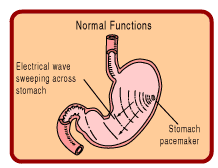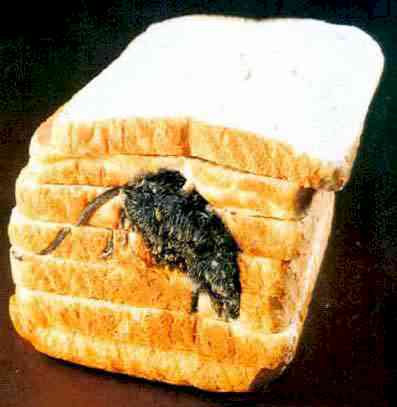Famine of Plenty
All You Can Eat and MoreLife is not a spectacle or a feast; it is a predicament. - George Santayana A greedy person and a pauper are practically one and the same. - Swiss Proverb
This story by Diane Baker Mason has been moved to a better position. I'd send you there automatically, but I don't know how. However, clicking Feast will take you there straightaway (it will open in a new window). Go ahead. It's worth it. (It's a great story about gluttony!)
Why Is a Stomach Not a Cannibal?Nothing is enough for the man to whom enough is too little. - Epicurus by Kathy Wollard How come the stomach doesn't digest itself? On 25 January, Scottish poet Robert Burns was born in 1759. To celebrate his birthday - called "Burns Night" - fans hold Burns suppers. Like turkey at Thanksgiving, the essential dish at a Burns supper is haggis. If you've never heard of haggis, the recipe may make you a bit squeamish. Traditional haggis is a mix of sheep livers, hearts and lungs, along with onions, spices and oatmeal. But the main ingredient is sheep's stomach. Burns Night revelers not only eat haggis, they read poetry to it. Especially one of Burn's most famous poems, "Address to a Haggis." If human beings can digest other animals' stomachs, it seems odd that our own emerge unscathed after the digestive acid bath of each meal. Luckily for us, a living stomach has ways to protect itself from itself. To carry it through a day's meals, the stomach makes about six cups of digestive juices. A key ingredient: extremely corrosive hydrochloric acid. Drop a piece of zinc into a cup of digestive juice, and the acid would gradually dissolve the metal (which isn't surprising if you've ever been sick and vomited: that burning in your throat is caused by acid ejected from your stomach). The acid is dissolved in a mix of water, electrolytes such as sodium, potassium and calcium, and enzymes called pepsins, which evolved to break down proteins. Like acid, pepsins are also threats to living cells. When you chew and swallow food, it sets off a chemical chain reaction. The stomach releases gastrin, a hormone signaling stomach cells called parietals to make hydrochloric acid from hydrogen atoms and chloride. Meanwhile, other cells - the chiefs - begin churning out a substance called pepsinogen. With the help of hydrochloric acid, water enters pepsinogen, transforming it into protein-chomping pepsin. Just as human beings use fire, the body has evolved ways to harness useful-but-threatening chemicals without harming itself. First, the stomach's lining of epithelial cells continuously regenerates itself. In the acid bath of each passing minute, some 500,000 epithelial cells are shed and replaced. So cells underneath remain protected from the harsh environment in the churning stomach sac. Second, there's the body's handy-dandy all-purpose protective slime: mucus. Mucus, made by the epithelial cells, forms a thick lining on the inner stomach wall. Stomach juices eat through, but mucus is continuously replenished. (An empty stomach can weigh 1 pound or more; 38% is slippery mucus.) Third, the stomach lining makes its own Alka-Seltzer - bicarbonate, an alkaline that neutralises acid. And stomach researchers say there seems to be a defense system they don't yet understand, in which the muscular organ can switch its environment from acid to alkaline, using molecules that act as "pH sensors." When the defenses fail - as when the stomach is overrun with the mucus-injuring bacteria H pylori - acidic juices can make painful sores in the stomach wall: ulcers. Source: Newsday print edition 21 January 2003 For articles on our sense of smell and how it impacts what we eat and drink, see also:
For articles on some of the unusual things some people eat, see also:
GastroparesisIn general, mankind, since the improvement of cookery, eats twice as much as nature requires. - Benjamin Franklin This tough looking word, pronounced gas-tro-par-EES-is, is simple enough in its meaning. Gastro means stomach. Paresis means weakness. Gastroparesis is a weak stomach. This condition is very common. It can be the cause of a number of abdominal complaints. It is usually not a serious problem and there are effective treatments available. How the Stomach Works
To understand gastroparesis, you first must understand how the stomach functions. The stomach has two parts. The upper portion is called the fundus which is where swallowed food and liquid collect. The lower portion is called the antrum. This is the stomach grinder. It is where food is churned back and forth until it is broken into small fragments and then squirted out into the duodenum, the first part of the small intestine. It may be a surprise to think of the stomach as being similar to the heart, yet this is really true. Both have an area within them called the pacemaker. This is where an electrical wave originates and then sweeps across the organ. Electrical waves cause the muscles in both the heart and stomach to contract. In the stomach, the pacemaker is in the upper portion. The wave sweeps down across the antrum causing it to contract, grind up food, and expel small amounts into the duodenum, the first part of the small bowel. The normal rate of contraction is about three times a minute, much slower than the heart, but quite adequate for the job. GastroparesisThis condition occurs when the rate of the electrical wave slows and the stomach contracts less frequently. Now the food just lays in the stomach relying on acid and digestive enzymes to break down the food and on gravity to empty the stomach. There are a number of causes for this condition:
It should be noted that not all of these disorders affect the pacemaker of the stomach. Some disorders weaken the stomach muscle itself so it can't respond to the pacemaker. In either case, the result is the same, gastroparesis. SymptomsThe usual symptoms of gastroparesis are a feeling of fullness after only a few bites of food, bloating, excessive belching, and nausea. At times there will be a vague, nagging ache in the upper abdomen but usually the pain is not sharp or crampy as might occur with ulcers or a gallbladder attack. There may be vomiting, heartburn, or regurgitation of stomach fluid into the mouth. Medications that reduce or eliminate stomach acid usually don't help much. DiagnosisThe diagnosis of gastroparesis starts with the medical history where the physician may suspect the diagnosis based on the symptoms. In severe cases, the physical exam and blood tests may show evidence of malnutrition, but usually the exam is normal. An upper GI barium x-ray measures how liquid barium leaves the stomach. Often this exam is normal. Upper endoscopy is a visual exam of the stomach using a lighted flexible tube. Mild sedation is usually given for this procedure. This exam should always be done to be certain there is not a blockage in the stomach. A gastric or stomach emptying test is presently the best method of making the diagnosis. In this test, a food, such as scrambled eggs, is labeled with a marker which can be seen by a scanner. Following ingestion, the scanner tracks the time it takes for the food to leave the stomach. In general, half the stomach contents should leave within about 90 minutes. A final test, which is not available everywhere, is the electrogastrogram (EGG). This test, like the EKG on the heart, measures the electrical waves that normally sweep over the stomach and precede each contraction. TreatmentFirst, if there is an underlying disorder, it needs to be treated effectively. Examples are good blood sugar control in the diabetic patient or thyroid medicine for someone with an underactive thyroid. Second, there may be a need to address diet and nutrition. When gastroparesis is mild, there are usually few food problems. However, if there is marked delay in stomach emptying, then attention to the diet is necessary. Fats, including vegetable oils, normally cause delay in emptying of the stomach, so foods that are high in fat need to be avoided. High fibre foods such as broccoli and cabbage tend to stay in the stomach, so these foods should be restricted when symptoms are severe. Liquids always leave the stomach faster than solid food so liquid type foods such as low-fat milkshakes should be used. Finally, frequent small feedings, 4 - 6 times a day, are usually more effective than larger meals, 2 or 3 times a day. A registered dietitian can be very helpful in providing advice in severe cases. The third treatment is medication. Source: www.gicare.com
But Can You Stomach This?
Source: www.thesun.co.uk sent to them by Matt Mint
Cooking with Possum:
|
 Animals
Animals Animation
Animation Art of Playing Cards
Art of Playing Cards Drugs
Drugs Education
Education Environment
Environment Flying
Flying History
History Humour
Humour Immigration
Immigration Info/Tech
Info/Tech Intellectual/Entertaining
Intellectual/Entertaining Lifestyles
Lifestyles Men
Men Money/Politics/Law
Money/Politics/Law New Jersey
New Jersey Odds and Oddities
Odds and Oddities Older & Under
Older & Under Photography
Photography Prisons
Prisons Relationships
Relationships Science
Science Social/Cultural
Social/Cultural Terrorism
Terrorism Wellington
Wellington Working
Working Zero Return Investment
Zero Return Investment


